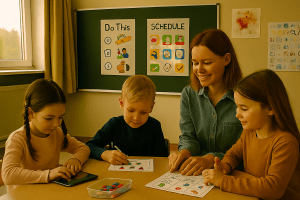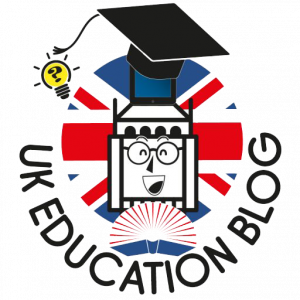Teaching children with learning differences requires a thoughtful, adaptable approach. These pupils may find traditional classroom methods challenging, and they can quickly fall behind without suitable support.
That’s where the role of the teaching assistant becomes invaluable. Working under the guidance of classroom teachers, teaching assistants offer tailored support that helps each child reach their full potential.
By using flexible, inclusive methods, they help build learning environments where pupils feel understood and encouraged. These classroom strategies are about making learning accessible, meaningful, and enjoyable.
1. Building Core Skills through Structured Support
 Children with learning differences benefit most from consistent, visual teaching strategies that are broken into manageable parts. Teaching assistants use multisensory and scaffolded methods that allow children to engage with learning in ways that make sense to them.
Children with learning differences benefit most from consistent, visual teaching strategies that are broken into manageable parts. Teaching assistants use multisensory and scaffolded methods that allow children to engage with learning in ways that make sense to them.
Whether it’s breaking tasks into simple steps or introducing visual cues for instructions, these methods reduce anxiety and increase engagement. A child who might otherwise feel overwhelmed can develop greater confidence and independence simply by having the right kind of support, explicit instruction, task structure and routine.
This type of support is explored in depth through structured training. Level 3 teaching assistant courses provide teaching assistants with the knowledge needed to support a range of learning needs. In particular, some Level 3 Teaching Assistant apprenticeship programmes cover support for learners with dyslexia, ADHD, autism, and language processing differences. These programmes are typically fully funded through the government’s Growth and Skills Levy and represent no cost to schools.
Learners benefit from an in-school mentor, as well as an apprenticeship tutor, and learn how to work closely with teachers to adapt resources to meet individual learner needs, playing an important part in inclusive classrooms.
2. Understanding the Everyday Realities of SEND Support
In almost every classroom, some children need extra help to access learning like their peers. Many children need help with social and emotional regulation before they can approach academic work. Teaching assistants must clearly understand how to provide daily, consistent support that adapts to individual learning differences. They must also take care not to “spoonfeed” children and to use scaffolds effectively to boost confidence, independence and self-esteem.
Rather than working in isolation, many teaching assistants are the primary point of contact for pupils requiring support, working under close direction from classroom teachers and SENCOs. They build trust with children, offering quiet guidance and adjustments that help prevent frustration, without creating a culture of over-reliance. Their input ensures that children who learn differently don’t miss out on the opportunity to progress with their classmates.
Completing a Level 3 Teaching Assistant Apprenticeship offers learners practical experience of working in a school and is a great introduction to the teaching assistant role. It also means support staff are better prepared to help deliver inclusive learning experiences. These insights allow teaching assistants to avoid over-taxing working memory, understand sensory overwhelm, use a range of communication techniques and suggest when it is time to take a break.
3. Incorporating Technology to Enhance Learning
 Digital tools have opened new avenues for supporting children with learning differences. Teaching assistants increasingly use apps and software that help pupils overcome specific challenges.
Digital tools have opened new avenues for supporting children with learning differences. Teaching assistants increasingly use apps and software that help pupils overcome specific challenges.
Text-to-speech tools allow children with reading difficulties to follow along with lessons. In contrast, speech-to-text tools allow pupils with limited writing ability to express themselves more freely. Visual scheduling apps and digital timers can help structure the day for children who struggle with transitions or time management.
With the knowledge gained from a Level 3 Teaching Assistant Apprenticeship, teaching assistants can begin to support learners with these tools. They learn to introduce technology as part of a broader learning strategy rather than relying on it as a quick fix. The key is always to support, not replace, engaged teaching.
4. Creating Spaces Where All Pupils Feel Safe and Supported
A thoughtfully arranged classroom environment helps children with learning differences feel secure. Teaching assistants contribute by ensuring that resources are accessible and the space encourages focus and calm.
Seating plans can be arranged to minimise distractions, and sensory-friendly corners give children a break when the environment feels overwhelming. Predictable routines and visual timetables help pupils settle and prepare for transitions. Regular check-ins, end-of-day reviews, and advance warnings before introducing changes can make a big difference.
Inclusive classrooms reinforce expectations using clear visual signs, labels, and visual behaviour cues. Many of these supports fall under the responsibility of the teaching assistant, who maintains them throughout the day while offering real-time reassurance and adjustments as needed.
5. Fostering Collaboration Between Teachers and Teaching Assistants
 Strong communication between teachers and teaching assistants is fundamentally important to ensure pupils receive consistent support and that regular observations about progress are being shared. Regular short meetings help both professionals remain aligned, particularly when working with children with learning differences.
Strong communication between teachers and teaching assistants is fundamentally important to ensure pupils receive consistent support and that regular observations about progress are being shared. Regular short meetings help both professionals remain aligned, particularly when working with children with learning differences.
Teaching assistants who undertake the Level 3 teaching assistant qualification learn how to work effectively with teachers and understand key elements of their school’s SEND policy.
Teachers offer curriculum knowledge and adaptive teaching strategies, while teaching assistants provide additional insights into how each child is responding to particular tasks and activities, including how they are getting on outside of the classroom, in the playground, or during PE lessons. Together, they can ensure each pupil can access the curriculum in a meaningful way. Some experienced TAs may also lead interventions outside of the main classroom, while HLTAs build up the skills required to do more whole-class teaching to provide cover for teachers.
Collaboration doesn’t have to be time-consuming. Shared planning documents and brief check-ins can maintain alignment even during busy school days, with some schools re-arranging timetables to allow daily 15-minute briefings with teachers. The insights trained teaching assistants contribute are especially valuable when completing a Level 3 teaching assistant course that focuses on specific learning needs.
6. Measuring Progress Beyond Grades and Tests
Standard assessments don’t always reflect the true growth of a child with learning differences. Teaching assistants play a key role in tracking subtle yet meaningful developments, building key skills in formative assessment and general observation.
Progress can be observed in improved independence, social skills, emotional regulation, or increased willingness to participate. These are often recorded through notes, photos of completed tasks, or pupil self-assessments using coloured cards or achievement charts.
Celebrating these steps helps children recognise their achievements and feel more motivated to learn. It also allows parents and carers to appreciate the full picture of their child’s development, not just academic scores.
Teaching assistants know when to pass valuable observations back to teachers, offering a well-rounded view reflecting learning and personal growth.
7. Creating Lasting Impact Through Targeted Support
Helping children with learning differences succeed requires more than good intentions; it demands informed, consistent support. Teaching assistants, especially those who undertake professional development such as the Level 3 Teaching Assistant Apprenticeship with SEND training, are key to making classrooms more inclusive and accessible.
By applying structured techniques, building learner independence and fostering strong relationships with both pupils and teachers, they contribute daily to better outcomes for children who learn differently. With the proper training, resources, and communication, every teaching assistant can help to create a classroom where all learners can thrive.
Author Profile

- Shirley Owen is a blogger and writer who enjoys writing blogs on education, technology and general news. An avid reader, she follows all the latest news & developments to report on them through her articles.
Latest entries
 educationDecember 11, 2025Making Education Accessible for Mobile Families that Travel
educationDecember 11, 2025Making Education Accessible for Mobile Families that Travel learningOctober 28, 20257 Daily Classroom Strategies Helping Children With Learning Differences Thrive
learningOctober 28, 20257 Daily Classroom Strategies Helping Children With Learning Differences Thrive  ed techSeptember 29, 2025How to use VR to Ace your next Exams
ed techSeptember 29, 2025How to use VR to Ace your next Exams educationSeptember 18, 2025A Guide to the European Accessibility Act for Schools and Universities
educationSeptember 18, 2025A Guide to the European Accessibility Act for Schools and Universities







